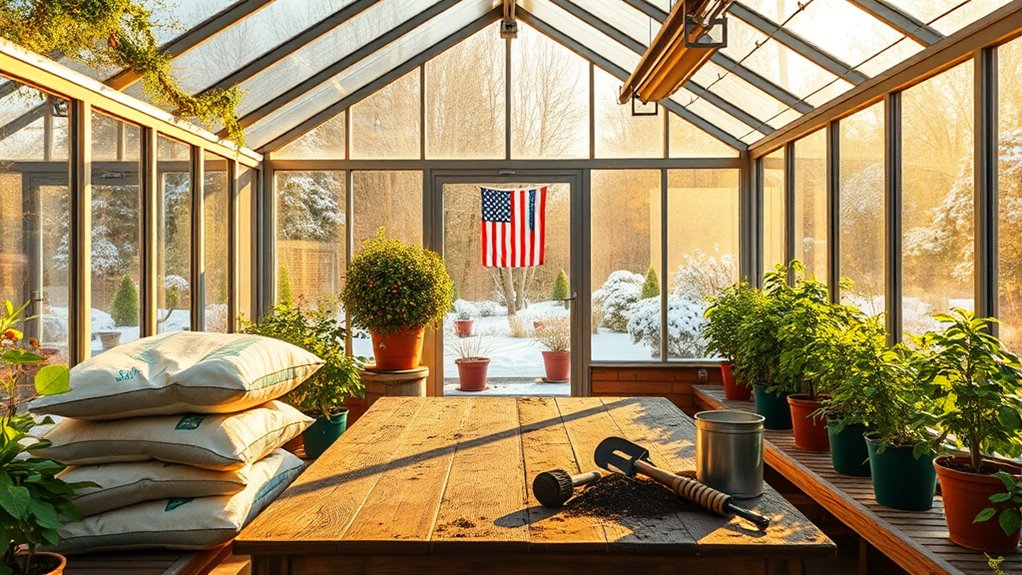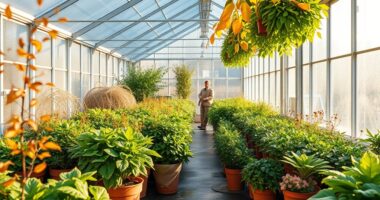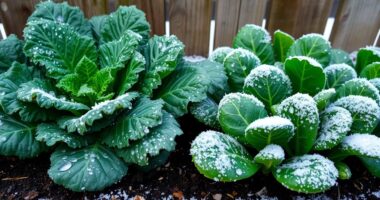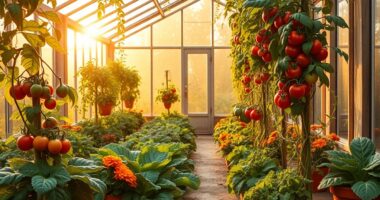To prepare your greenhouse for winter and summer, adjust your watering schedule to match seasonal needs—watering more often in summer and less in winter. Keep pests in check by inspecting regularly and maintaining cleanliness. Make certain your greenhouse is structurally sound, cleaning surfaces and fixing leaks. Manage ventilation and climate controls to suit each season, and support healthy soil and plant conditions. Staying proactive with these tips will help you maintain a thriving greenhouse year-round—discover more tips to optimize your space.
Key Takeaways
- Adjust watering schedules seasonally to prevent overwatering in winter and support evaporation in summer.
- Regularly inspect and maintain ventilation, heating, and cooling systems for optimal environmental control.
- Clean and disinfect greenhouse surfaces, remove debris, and eliminate pest hiding spots before seasonal changes.
- Monitor soil moisture with meters and support plant health through proper hydration tailored to each season.
- Inspect structural integrity and adjust climate controls to ensure the greenhouse is prepared for winter or summer conditions.
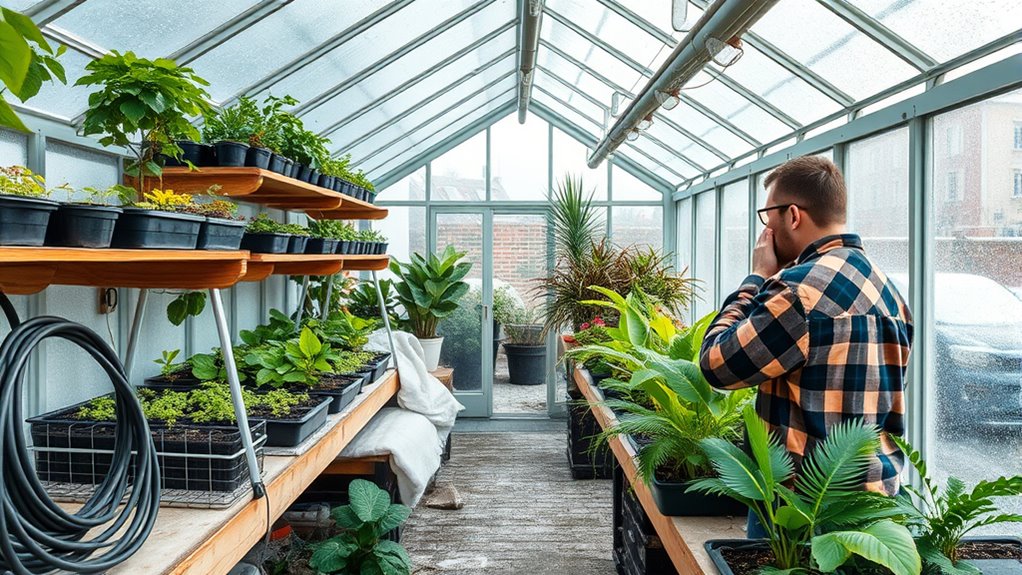
As the seasons change, it is essential to perform seasonal maintenance to keep your greenhouse in top condition. This process ensures your plants stay healthy and your greenhouse remains functional regardless of the weather outside. One of the first steps is adjusting your watering schedule to match the seasonal needs. During summer, plants generally require more frequent watering due to increased heat and evaporation, so you might need to water daily or even twice a day for some crops. Conversely, in winter, watering should be reduced to prevent overwatering and root rot, especially since cooler temperatures slow plant growth and moisture evaporation. Keep an eye on soil moisture levels and use a moisture meter if necessary to avoid guesswork. Consistent watering helps plants thrive and prevents stress that could make them vulnerable to pests and diseases. Proper watering is also crucial during juice cleansing, as it supports detoxification and overall health.
Along with water management, pest control becomes even more essential as seasons change. Warmer months tend to bring an increase in pests like aphids, whiteflies, and spider mites, which can quickly infest your plants if left unchecked. Regularly inspect your plants for signs of pests and take proactive steps, such as introducing beneficial insects or applying organic insecticides. In winter, pests are less active but can still pose a threat if you’re growing indoors or in a heated greenhouse. Make sure to clean and disinfect your greenhouse surfaces frequently to prevent pest buildup. Removing debris, dead plant material, and weeds reduces hiding spots for pests, making your pest control efforts more effective. Maintaining proper ventilation systems helps regulate temperature and humidity, further deterring pest infestations. Additionally, understanding pest lifecycles can help you time your interventions more effectively. Regular monitoring and environmental control are key tools to keep pests at bay throughout the year.
Furthermore, inspecting and maintaining your greenhouse cover can prevent drafts and leaks that might disrupt your controlled environment, which is vital for managing pest and disease pressures effectively. Regularly checking and adjusting climate controls such as heaters, fans, and humidifiers can optimize your greenhouse environment and reduce pest problems.
Frequently Asked Questions
How Do I Prevent Pests During Seasonal Changes?
To prevent pests during seasonal changes, you should focus on effective pest prevention and seasonal pest management strategies. Regularly inspect plants for signs of pests, and remove any affected foliage promptly. Keep your greenhouse clean, eliminate standing water, and introduce natural predators or organic repellents. Sealing gaps and doors also helps avoid pests from entering. These proactive steps ensure your greenhouse stays pest-free, regardless of seasonal shifts.
What Are the Best Ventilation Tips for Extreme Temperatures?
You might think ventilation isn’t vital during extreme temperatures, but it’s key for healthy plants. Make certain your ventilation system promotes ideal airflow management by opening vents or windows during hot weather and using exhaust fans or shade cloths to reduce heat buildup. In cold weather, use adjustable vents to prevent drafts. Proper ventilation helps maintain a stable environment, preventing heat stress or frost damage, keeping your greenhouse thriving year-round.
How Often Should I Inspect Greenhouse Seals and Insulation?
You should inspect your greenhouse seals and insulation checks at least once every three months. Regular seal maintenance guarantees that gaps or damage don’t compromise temperature control or humidity. During inspections, look for cracks or wear, and replace or repair as needed. Keeping seals and insulation in good condition helps maintain a stable environment, preventing energy loss and protecting your plants from extreme weather conditions.
Are There Specific Plants That Require Special Winter or Summer Care?
Some plants need special winter or summer care, especially those with specific dormancy needs or sensitive to temperature changes. You should perform seasonal pruning to promote healthy growth and reduce stress. During winter, protect plants that require dormancy by adjusting watering and light levels. In summer, guarantee proper ventilation and hydration. Understanding each plant’s specific needs helps you maintain a thriving greenhouse year-round.
How Can I Automate Seasonal Adjustments for Climate Control?
You can automate seasonal adjustments for climate control by installing climate sensors that monitor temperature, humidity, and light levels. Connect these sensors to an automated watering system and ventilation controls, allowing your greenhouse to respond dynamically to changing conditions. This setup helps maintain ideal environments year-round, reducing manual effort and ensuring your plants thrive through seasonal shifts. Automation makes climate management efficient and precise, protecting your plants in any season.
Conclusion
As the seasons change, your greenhouse becomes a sanctuary of growth and renewal. Picture yourself gently closing the vents before winter’s chill or opening them wide to greet summer’s warmth. With each maintenance task, you’re nurturing a vibrant haven, ready to embrace the frost or the sun’s embrace. By tending to your greenhouse now, you guarantee it stays lush and thriving, a beautiful demonstration of your care through every season’s ebb and flow.
